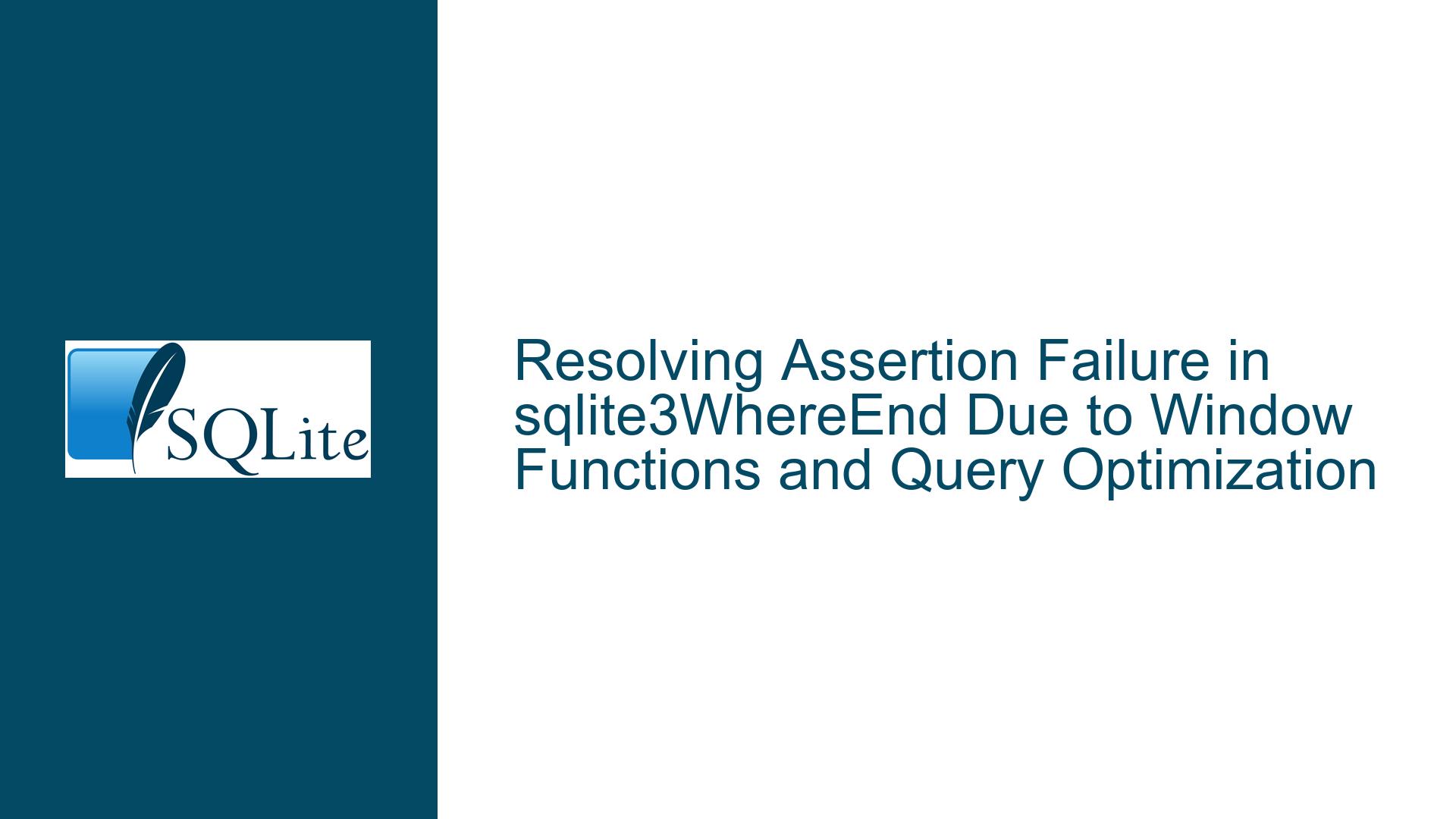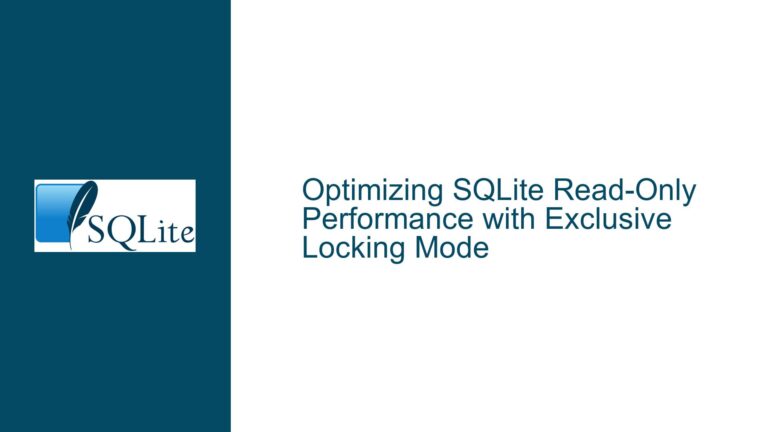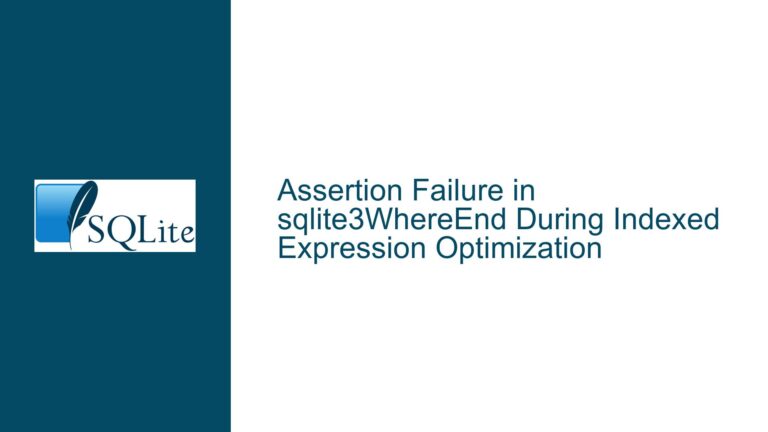Resolving Assertion Failure in sqlite3WhereEnd Due to Window Functions and Query Optimization
Window Function-Driven Assertion Failure in Complex View Updates
The core issue revolves around an assertion failure triggered during execution of an UPDATE query involving a view with nested window functions. The error manifests as a crash in sqlite3WhereEnd when SQLite attempts to process a combination of window functions, subqueries, and joins within a view definition. This failure is directly tied to query optimization pathways, specifically the SQLITE_Coroutines optimization flag. The problem was identified in SQLite version 3.41.0 (commit 4fc1904b8e18c7d4) and traced to changes introduced in February 2021. A bisect operation narrowed the faulty commit to 416c898bfb8ff963, with the fix applied in subsequent releases (trunk and branch-3.41).
The assertion (pLoop->wsFlags & WHERE_IDX_ONLY)==0 || cursorIsOpen(v,pOp->p1,k) || pOp->opcode==OP_Offset fails because the query optimizer assumes a cursor state that does not hold true when processing the complex view structure. The view v1 includes a self-join on v0, an ORDER BY clause with a windowed aggregate (sum(0) OVER(...)), and a nested WINDOW definition. The UPDATE statement further complicates execution by introducing an nth_value window function and a FROM clause subquery. When optimizations like SQLITE_Coroutines are enabled, the planner generates a query plan that violates cursor handling invariants during the WHERE clause processing phase.
Query Structure and Optimization Interactions Leading to Cursor State Mismatch
1. Window Function Nesting and View Materialization
The view v1 combines a self-joined table with a window function that includes a nested SELECT in its PARTITION BY clause. This creates a multi-layered execution context where the query planner must materialize intermediate results. Window functions like sum(0) OVER(...) and nth_value(0,0) OVER() require SQLite to maintain cursor states across partitioned data segments. The presence of a nested WINDOW y AS (PARTITION BY 0) adds another layer of complexity, as SQLite must resolve window definitions before applying them to the outer query.
2. UPDATE-FROM Syntax and Coroutine Optimization
The UPDATE...FROM syntax introduces a correlated subquery (SELECT 0 FROM v0) that interacts with the view v1. The SQLITE_Coroutines optimization transforms subqueries into co-routines—separate, interleaved execution threads—to avoid materializing temporary tables. However, in this scenario, the combination of the view’s window functions and the UPDATE’s FROM clause causes the coroutine mechanism to mishandle cursor lifecycle management. Specifically, the cursor for the base table v0 might be closed prematurely during the WHERE clause evaluation, violating the assertion that checks for an open cursor when using index-only scans (WHERE_IDX_ONLY).
3. Query Planner Assumptions in WHERE Clause Processing
The sqlite3WhereEnd function finalizes the WHERE clause processing by closing cursors and cleaning up loops. The assertion failure indicates that the planner expected either (a) the loop not to use an index-only scan, (b) the cursor to remain open, or (c) the operation to be OP_Offset. The WHERE_IDX_ONLY flag suggests an index-only scan was attempted, but the cursor was closed due to incorrect coroutine handling. This mismatch arises because the coroutine optimization skips steps that would normally keep the cursor open for subsequent operations like window function evaluation.
Mitigating the Assertion Failure Through Optimization Control and Query Restructuring
Immediate Workaround: Disabling SQLITE_Coroutines
To bypass the assertion failure without code changes, disable the SQLITE_Coroutines optimization using PRAGMA testctrl before executing the problematic query:
.testctrl optimizations 0x02000000; -- Hex mask for SQLITE_Coroutines
This forces SQLite to materialize subquery results instead of using coroutines, avoiding the cursor state mismatch. However, this may degrade performance for other queries relying on coroutine optimizations.
Version Upgrade and Patch Application
The fix was committed to SQLite’s trunk and backported to branch-3.41. Upgrading to SQLite 3.41.1 or later resolves the issue. Verify the version with:
SELECT sqlite_version();
If using a custom build, ensure the source includes commits after 416c898bfb8ff963 (February 2021). For embedded systems, rebuild SQLite with the patched where.c module, paying attention to changes in the sqlite3WhereEnd function.
Query Simplification and Window Function Isolation
Redesign the view v1 to isolate window functions from joins and nested subqueries. For example, separate the windowed aggregate into a CTE:
CREATE VIEW v1 AS
WITH window_cte AS (
SELECT *, sum(0) OVER (PARTITION BY (SELECT 0 WINDOW y AS (PARTITION BY 0))) AS s
FROM v0
)
SELECT * FROM window_cte JOIN v0 A ORDER BY s;
This reduces the complexity of the view’s execution plan. Similarly, rewrite the UPDATE to avoid mixing window functions with FROM clauses:
UPDATE v1 SET c0 = (SELECT nth_value(0,0) OVER() FROM (SELECT 0 FROM v0))
WHERE c0 IS 0 RETURNING 0;
Cursor State Debugging with EXPLAIN and Logging
Enable SQLite’s debugging traces to analyze cursor states during query execution:
export SQLITE_ENABLE_WHERETRACE=1
export SQLITE_ENABLE_SELECTTRACE=1
./sqlite3 < poc 2> debug.log
Inspect the debug.log for WHERE clause processing steps, noting cursor operations (OP_OpenRead, OP_Close). Look for premature cursor closures in the UPDATE’s WHERE loop.
Schema Normalization and Indexing Strategies
Add covering indexes to v0 to support index-only scans without relying on cursor tricks:
CREATE INDEX idx_v0_c0 ON v0(c0) WHERE c0 IS NOT NULL;
This ensures the WHERE_IDX_ONLY optimization can proceed safely by providing all required columns from the index, reducing cursor dependency.
Long-Term Code Analysis: Coroutine-Cursor Interactions
For developers modifying SQLite’s source, audit the interaction between coroutines (src/coroutine.c) and cursor management in sqlite3WhereEnd. Key areas include:
- Coroutine Cursor Lifetimes: Ensure coroutines maintain open cursors for all parent frames that reference them.
- WHERE_IDX_ONLY Validation: Add pre-assertion checks in
sqlite3WhereEndto verify cursor openness before assuming index-only scan viability. - Window Function Materialization: Modify the window function processor (
window.c) to materialize results earlier, avoiding cursor state dependencies duringWHEREprocessing.
Testing Strategies for Window Function Edge Cases
Implement regression tests combining:
- Nested window functions with
PARTITION BYsubqueries UPDATE-FROMsyntax on views with windowed aggregates- Self-joins and recursive CTEs in view definitions
Use SQLite’stestfixtureharness to automate these scenarios, ensuring future optimizations do not reintroduce the cursor state bug.
Contributing to SQLite’s Optimization Flag Governance
Engage with SQLite’s development community to refine optimization flag interactions. Propose a runtime check for incompatible flag combinations (e.g., SQLITE_Coroutines with certain window function usages). This could involve extending the sqlite3_test_control API to validate optimization masks against query structures before execution.
Proactive Measures for Avoiding Query Planner Assertions
- Incremental Query Construction: Build complex views and queries incrementally, testing each added element (joins, window functions, subqueries) for planner stability.
- Optimization Flag Sandboxing: Use
.testctrl optimizationsto disable non-essential flags when introducing new SQL constructs, re-enabling them selectively after validation. - Cursor Hygiene in Custom Extensions: When developing SQLite extensions, explicitly manage cursors with
sqlite3VdbeCursorRestoreandsqlite3VdbeCursorMovetoto prevent state mismatches. - Assertion-Enabled Debug Builds: Always test queries against SQLite compiled with
-DSQLITE_DEBUGto surface hidden planner assumptions. - Community Patch Monitoring: Subscribe to SQLite’s commit log and mailing list for fixes related to window functions and coroutines, applying patches promptly.






